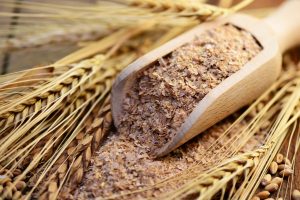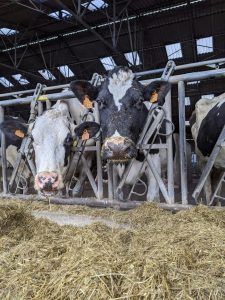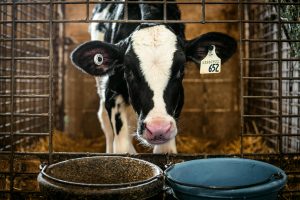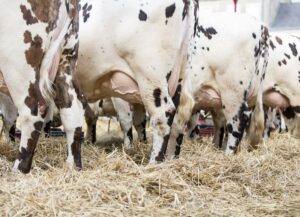Álvaro García
Protein nutrition is one of the largest recurring costs in dairy production, second only to energy. In regions where high-quality forages are scarce and protein-rich feedstuffs must be imported, the challenge intensifies: nutritionists must balance cow requirements against volatile global markets, shipping costs, and sustainability concerns. Imported protein concentrates such as soybean meal, canola meal, and dried distillers’ grains with solubles (DDGS) are frequently used to supply metabolizable protein (MP) and essential amino acids, but their price reflects not only commodity value but also logistics, tariffs, and currency fluctuations.
Traditional formulation practices often oversupply crude protein (CP) to cover amino acid requirements. While effective for sustaining milk production, this approach is economically inefficient and environmentally costly: excess dietary nitrogen is excreted in manure and urine, increasing nutrient losses and greenhouse gas emissions. For dairies dependent on imported feed, such inefficiencies directly raise costs and reduce competitiveness.
Advances in amino acid nutrition have enabled more precise feeding. Supplementation with rumen-protected amino acids (RP-AA), particularly methionine and lysine, allows diets to be formulated with lower CP while still meeting amino acid requirements. This improves nitrogen efficiency, reduces excretion, and can lower feed costs. However, RP-AA products carry a premium, and their inclusion must be weighed against the cost and nutrient yield of imported concentrates. The critical question becomes: under what circumstances is it more economical to supply amino acids directly via RP-AA, and when is reliance on bulk protein meals more appropriate?
Addressing this requires moving beyond cost per ton of feedstuff to a framework based on cost per unit of usable nutrients, namely digestible MP, and limiting amino acids. Expressing value in this way enables dairies to allocate feed dollars more effectively, improving ration efficiency while reducing the nitrogen footprint of milk production.
Imported protein concentrates
Among the most widely traded protein sources for dairy rations are soybean meal, canola meal, DDGS, and sunflower meal. These ingredients differ in CP concentration, rumen-undegradable protein (RUP), amino acid profile, and cost efficiency. When evaluated solely by price per ton, they may appear attractive; however, a more informative comparison is cost per kilogram of CP or, more critically, cost per kilogram of RUP and key amino acids.
Soybean meal, at 48% CP, remain the international benchmark, with high lysine content and a competitive cost per unit of CP. Yet its high degradability in the rumen makes its RUP expensive. Canola meal (37% CP) offers a favorable amino acid profile but once adjusted for bypass protein, it often costs more than soybean meal. DDGS, with ~55% of CP as RUP, perform better on a bypass basis, but their lower lysine content and variability limit their role as a primary amino acid source. Sunflower meal is the least costly per ton but deliver low amino acid density (and less energy), raising its cost per unit of usable protein.
Table 1 summarizes these differences, showing that the cheapest concentrate on a per-ton basis is not necessarily the most economical source of digestible protein. This underscores why cost comparisons must be grounded in nutrient yield rather than crude composition alone, and why nutritionists in forage-deficit regions increasingly turn to RP-AA as a complementary strategy.
Table 1. Composition and economics of common imported protein concentrates | |||||||
Feedstuff | Crude Protein (%) | RUP (% of CP) | Lysine (% of CP) | Methionine (% of CP) | Typical Import Price ($/ton) | Cost per kg CP ($) | Cost per kg RUP ($) |
Soybean Meal (48% CP) | 48 | 44 | 6.3 | 1.4 | 600 | 1.25 | 2.84 |
Canola Meal | 37 | 38 | 6.0 | 1.9 | 450 | 1.22 | 3.20 |
DDGS | 30 | 55 | 2.8 | 1.5 | 350 | 1.17 | 2.12 |
Sunflower Meal | 32 | 35 | 2.5 | 1.2 | 300 | 0.94 | 2.68 |
The economic choice between imported protein concentrates and supplementation with RP-AA depends on these relative costs. Where imported concentrates are expensive or limited in amino acid density, RP-methionine and RP-lysine often provide a more cost-effective solution to achieve amino acid balance without overfeeding crude protein.
Taken together, the comparisons in Table 1 show that imported protein meals vary widely in their nutrient yield and cost efficiency. Even the most favorable sources, such as soybean meal, remain inefficient suppliers of limiting amino acids when evaluated on a cost-per-gram basis. This sets the stage for Table 2 below, which contrasts conventional meals with RP-AA. The results highlight that although RP-AA products are more expensive per kg, they deliver AA far more efficiently, often at a lower cost per gram of digestible lysine or methionine. This economic contrast underscores why precision supplementation with RP-AA is increasingly seen as a practical complement to imported protein concentrates in dairy rations.
Comparative economics of RP-AA vs imported protein concentrates
Table 2 compares the cost-effectiveness of supplying amino acids through conventional protein concentrates versus RP-AA. Although soybean meal, canola meal, and DDGS are common imports, their delivery of key amino acids is diluted. For example, soybean meal supplies about 25 g of lysine per kg of product, while canola meal supplies only about 6 g of methionine per kg. When these figures are expressed on a cost-per-gram basis, conventional meals are less efficient sources of these limiting amino acids than RP-AA.
By contrast, RP-lysine, and RP-methionine, though expensive per kg of product, provide hundreds of grams of the target AA per kg. After adjusting for digestibility, their cost per gram of effective nutrient is often lower than that of imported meals.
This comparison demonstrates that RP-AA can be a more economical way to meet specific amino acid requirements, especially in regions where protein meals are expensive or variable in quality (Middle East). The practical implication is that RP-AA are not substitutes for protein concentrates, which remain necessary for overall metabolizable protein supply, but precision tools that allow crude protein levels to be reduced without compromising performance. In this way, they improve both the cost efficiency of rations and the nitrogen efficiency of milk production.
Table 2. Comparative economics of rumen-protected amino acids versus imported protein concentrates | ||||||
Feed/Amino Acid | Typical Inclusion Form | Nutrient Supplied | Digestibility (%) | Cost ($/kg product) | Effective Nutrient Supplied (g/kg) | Cost per g Effective Nutrient ($) |
Soybean Meal | Meal (48% CP) | Lysine ~6.3% of CP | ~85 | 0.60 | 25 | 0.024 |
Canola Meal | Meal (37% CP) | Methionine ~1.9% of CP | ~80 | 0.45 | 6 | 0.075 |
DDGS | Byproduct (30% CP) | Lysine ~2.8% of CP | ~70 | 0.35 | 6 | 0.058 |
RP-Lysine | Coated granules | Lysine | 60 | 6.00 | 600 | 0.010 |
RP-Methionine | Coated granules | Methionine | 75 | 8.00 | 750 | 0.011 |
Economic considerations in protein supplementation
The choice between imported protein meals and rumen-protected amino acids (RP-AA) is not purely nutritional but fundamentally economic. Dairies must evaluate not only the direct cost of feedstuffs but also their contribution to milk income, nitrogen efficiency, and sustainability. Three key considerations stand out:
- Cost of usable nutrients, not just crude protein: Prices per ton can be misleading. A protein meal that appears cheap may supply far fewer grams of digestible lysine or methionine than a more expensive alternative. As Tables 1 and 2 demonstrate, RP-AA can often supply these nutrients at a lower cost per effective gram than conventional meals.
- Milk response and Income Over Feed Cost (IOFC): The economic value of amino acid supplementation depends on the milk response. If RP-lysine or RP-methionine raises milk protein yield or component percentages, the additional milk income must be weighed against supplement costs. In many cases, the increase in milk protein yield more than offsets the cost of RP-AA, especially where milk is priced on solids content.
- Risk management and supply security: Imported protein concentrates are subject to global price swings, trade disruptions, and variable quality. RP-AA, while costly, provides a consistent and predictable source of limiting amino acids. Using them strategically can reduce dependence on volatile commodity markets and improve ration consistency.
Practical guidelines for decision-making
- When imported protein prices are low: Bulk meals provide the most cost-effective source of metabolizable protein. RP-AA may still be justified if specific amino acid requirements are not met.
- When protein prices rise or quality declines: RP-AA become increasingly attractive, as their cost per gram of digestible nutrient may undercut that of conventional concentrates.
- When milk is priced on protein yield: Precision supplementation with RP-AA has greater economic impact, as improvements in protein content directly increase revenue.
- In sustainability-sensitive systems: RP-AA allow reductions in dietary crude protein, improving nitrogen efficiency and lowering the environmental footprint of dairies, a factor of growing importance in global markets.
Beyond lysine and methionine
Although methionine and lysine are recognized as the first-limiting amino acids in most dairy rations, the role of branched-chain amino acids (BCAA: leucine, isoleucine, and valine) is gaining attention, particularly in forage-based systems. In regions where diets rely heavily on roughage due to the excessive cost of imported concentrates, BCAA become increasingly important for both microbial and host metabolism.
BCAA serve several critical functions. They function as substrates for microbial protein synthesis in the rumen, which can be limited when diets contain abundant fiber but insufficient fermentable carbohydrate. They also provide direct precursors for milk protein synthesis, with leucine playing a role in signaling pathways that regulate protein accretion in the mammary gland. Additionally, BCAA are utilized as alternative energy substrates, helping sustain milk production when glucose supply is restricted.
From an economic perspective, the situation parallels that of methionine and lysine. Conventional protein meals deliver BCAA only in diluted amounts, whereas targeted supplementation, whether through rumen-protected forms, or by choosing protein concentrates richer in BCAA, can offer a more efficient way to close nutritional gaps. In forage-heavy systems, where microbial protein yield may not fully meet the cow’s amino acid needs, ensuring an adequate supply of BCAA could improve both nitrogen efficiency and milk component yield.
Table 3. Branched-chain amino acid (BCAA) content and economics of protein sources | ||||||
Feedstuff | Crude Protein (%) | Leucine (% of CP) | Isoleucine (% of CP) | Valine (% of CP) | Typical Import Price ($/ton) | Cost per g BCAA ($) |
Soybean Meal (48% CP) | 48 | 7.7 | 4.7 | 5.2 | 600 | 0.022 |
Canola Meal | 37 | 6.6 | 4.3 | 4.8 | 450 | 0.021 |
DDGS | 30 | 12.0 | 4.0 | 5.0 | 350 | 0.018 |
Sunflower Meal | 32 | 6.5 | 3.5 | 4.0 | 300 | 0.020 |
RP-Leucine | NA | 100 | 0 | 0 | 10000 | 0.010 |
RP-Isoleucine | NA | 0 | 100 | 0 | 12000 | 0.012 |
RP-Valine | NA | 0 | 0 | 100 | 12000 | 0.012 |
Table 3 compares the branched-chain amino acid (BCAA: leucine, isoleucine, and valine) content of common imported protein meals with that of rumen-protected BCAA supplements. Conventional meals such as soybean meal and canola meal provide moderate amounts of BCAA, while DDGS stand out for their particularly high leucine content (around 12% of crude protein). Sunflower meal supplies lower concentrations of all three BCAA, consistent with its lower nutritional density.
When these values are expressed on a cost basis, the pattern mirrors that seen with methionine and lysine: protein meals deliver BCAA in diluted amounts, making them more expensive sources of effective nutrients compared with targeted rumen-protected products. For instance, while soybean meal may appear affordable on a per-ton basis, the cost per gram of delivered BCAA is double that of rumen-protected leucine. Similar relationships hold for isoleucine and valine.
This highlights the potential role of rumen-protected BCAA as precision supplements, particularly in forage-heavy diets where microbial protein synthesis may not fully supply the cow’s amino acid requirements. By providing concentrated, digestible BCAA, these supplements can improve nitrogen efficiency, support microbial activity, and enhance milk protein synthesis in situations where conventional meals alone may be insufficient.
Taken together, tables 1 through 3 illustrate a progression in how protein supplementation should be evaluated. Table 1 shows that imported protein concentrates vary widely in nutrient yield, and their apparent low cost per ton often masks a higher cost per unit of usable protein. Table 2 demonstrates that rumen-protected methionine and lysine, though more expensive per kg of product, can deliver limiting AA at a lower effective cost than conventional meals. Table 3 extends this concept to BCAA, highlighting their importance in forage-heavy systems where microbial protein synthesis may be constrained. Viewed collectively, these comparisons deliver a core message: the economics of protein feeding must shift from crude protein metrics to cost per unit of digestible, limiting AA. By doing so, dairies can improve nitrogen efficiency, reduce ration costs, and sustain productivity in environments where imported protein is both essential and expensive.
Conclusion
Protein supplementation in dairy nutrition is an economic decision as much as a nutritional one. Evaluating feeds by cost per gram of digestible amino acids, rather than crude protein alone, reveals that imported protein concentrates, rumen-protected methionine and lysine, and even branched-chain amino acids each have complementary roles. Strategic use of these tools enables dairies to reduce protein costs, improve nitrogen efficiency, and maintain milk production in systems heavily dependent on imported feeds.
The full list of references used in this article is available upon request.
© 2025 Dellait Knowledge Center. All Rights Reserved.









